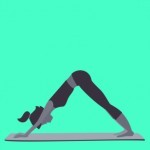 By Faye Martins
By Faye Martins
How do teachers build strength? When you take a Hatha Yoga teacher training course, you meet people of all kinds, but they have one physical aspect in common. Usually, hatha practitioners are deceptively strong and people who don’t practice wonder how it’s done. Although, there are many asanas to choose from let’s look at two of them that almost everyone can do and both of them are in the Sun Salutation series (Surya Namaskar).
Two of the most common yoga poses are downward dog and plank pose. When we see people practicing the asanas, they might look rather easy. Once you try it for yourself, you’ll see that there are a lot of things to be paying attention to in order to perform each pose properly. When performed properly and regularly, both of these poses can build strength and produce amazing benefits.
Downward Dog
Downward dog might be the iconic asana for yoga. Many people have seen or heard about the pose in some context. It’s often the go-to image that is commonly associated with yoga. Those of us who practice on a regular basis know that there is much more to yoga training than downward dog, but it is a valuable and worthwhile pose that is deserving of at least some recognition.
Young toddlers build strength often. because they naturally assume a downward dog-like pose when they begin to explore how their bodies move and what they can do. When adults get their bodies into similar positions, it probably looks the same but a lot more is going on within the body than meets the eye.
To properly perform downward dog, remember to place the hands firmly at the edge of your mat with your arms shoulder-width apart. Your feet should be hip-width apart with the ultimate goal of pressing the heels into the mat. Rest your weight evenly between the hands and the legs, pressing your spine up towards the ceiling.
The benefits of performing downward dog include stronger hands and wrists, hamstrings, lower back, calves and the Achilles tendon. This asana encourages the shoulders to elongate and it will also decrease back pain. Downward dog also decreases tension while improving circulation. Performing this yoga pose on a regular basis will decrease chronic headaches and reduce anxiety.
Plank
Plank pose can actually begin in downward facing dog. To transition, just lower the upper body forward so the shoulders rest directly above the wrists. Hold the body in a straight, firm line from head to toes without dipping or raising the hips. It’s important to focus on sliding the shoulder blades down and back away from the ears.
Plank pose is an amazing way to build strength and it’s core strengthener. It will also tone the arms, shoulders, wrists and back. It improves your posture by working on a nice, elongated spine. By strengthening the abdominal muscles, this asana will decrease any back pain you might experience on a regular basis. This can be a challenging yoga asana to hold, which will also help improve your concentration and focus.
© Copyright – Aura Wellness Center – Publications Division
To see our selection of Yoga teacher training courses, please visit the following link.
https://aurawellnesscenter.com/store/
Free Report, Newsletter, Videos, Podcasts, and e-Book, “Yoga in Practice.”
If you are a Yoga Teacher, studio manager, blogger, e-zine, or website publisher, and are in need of quality content, please feel free to use my blog entries (articles). Please be sure to reprint each article, as is, including the resource box above. Namaste!

1 thought on “Yoga Instructor Training: Build Strength”